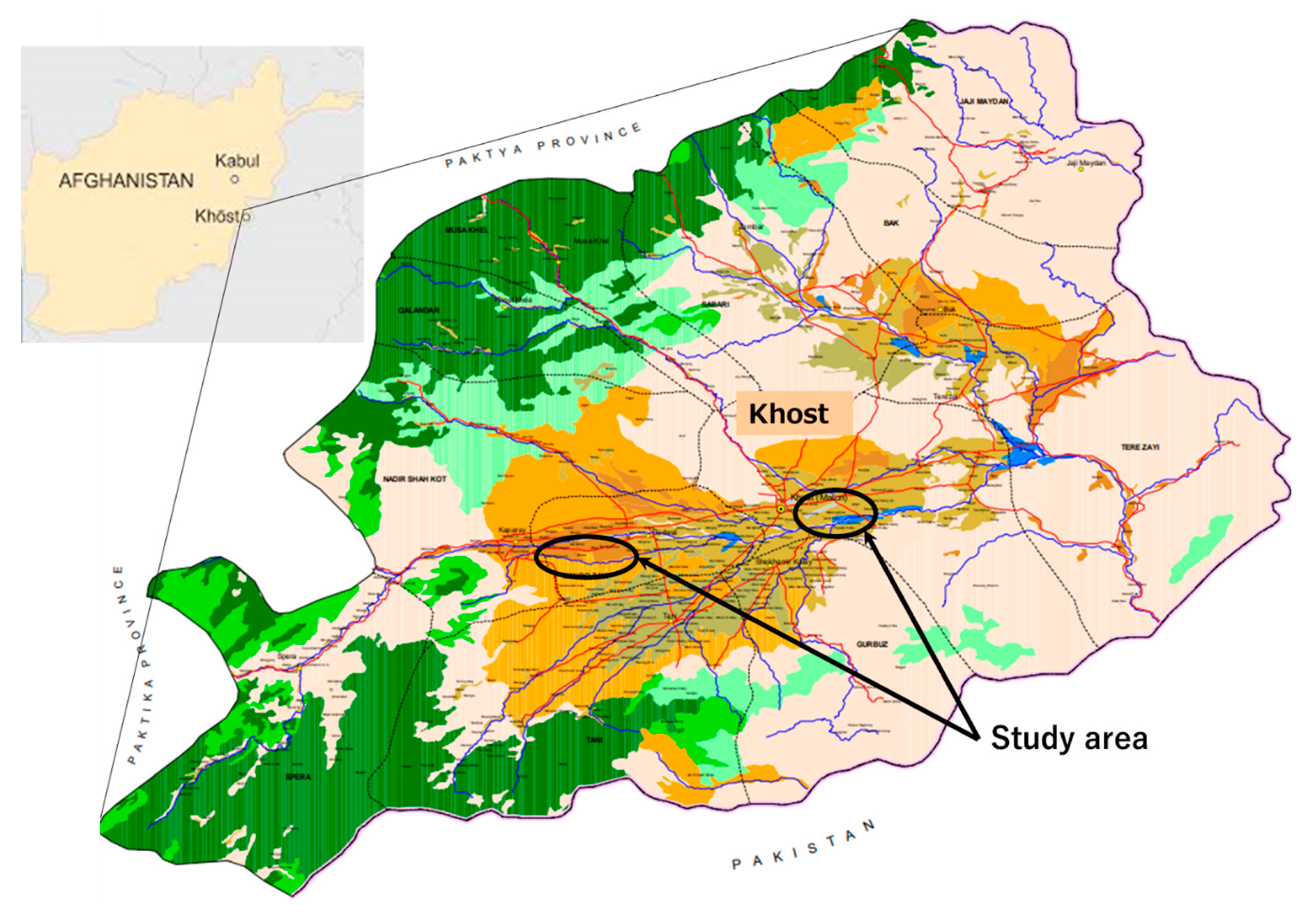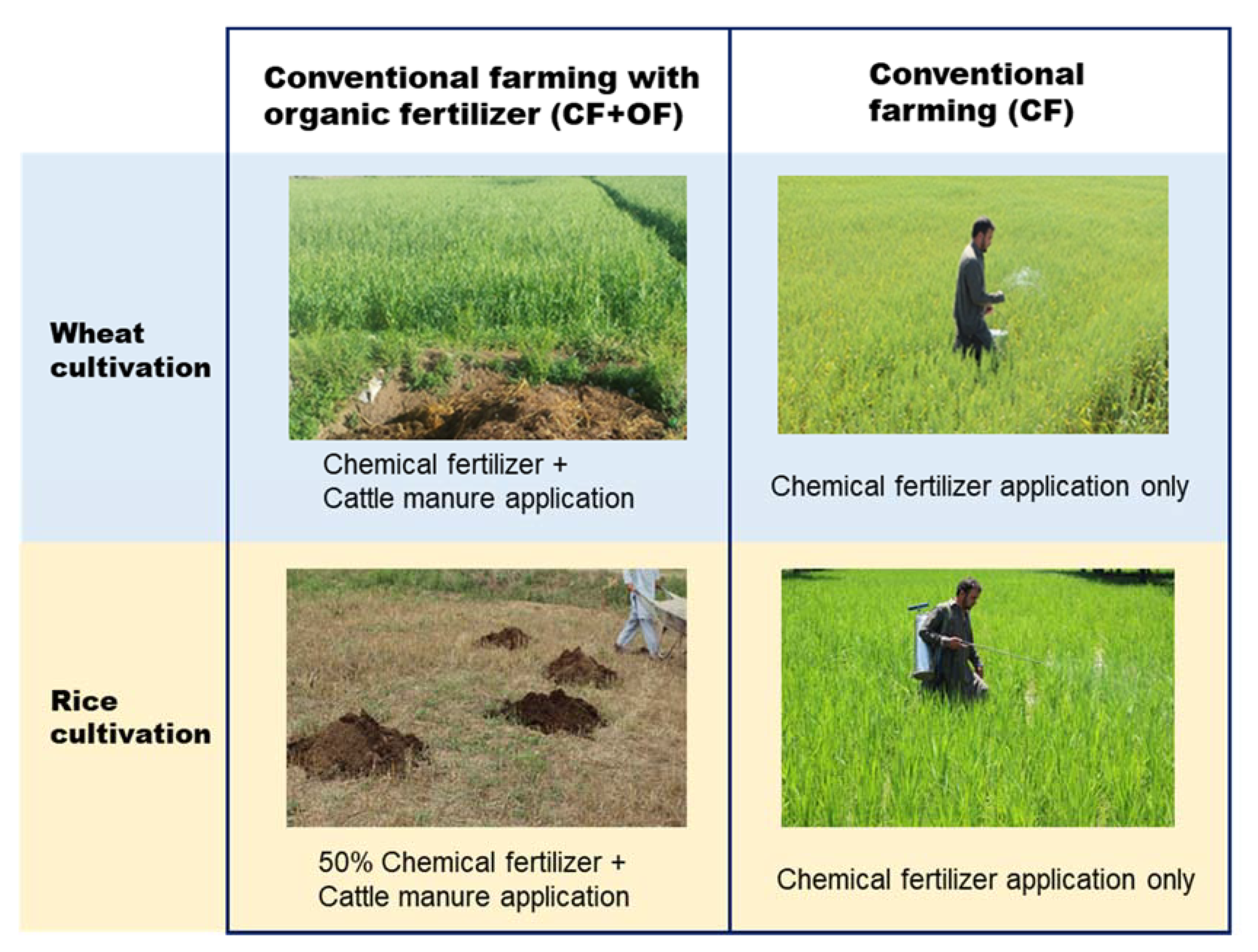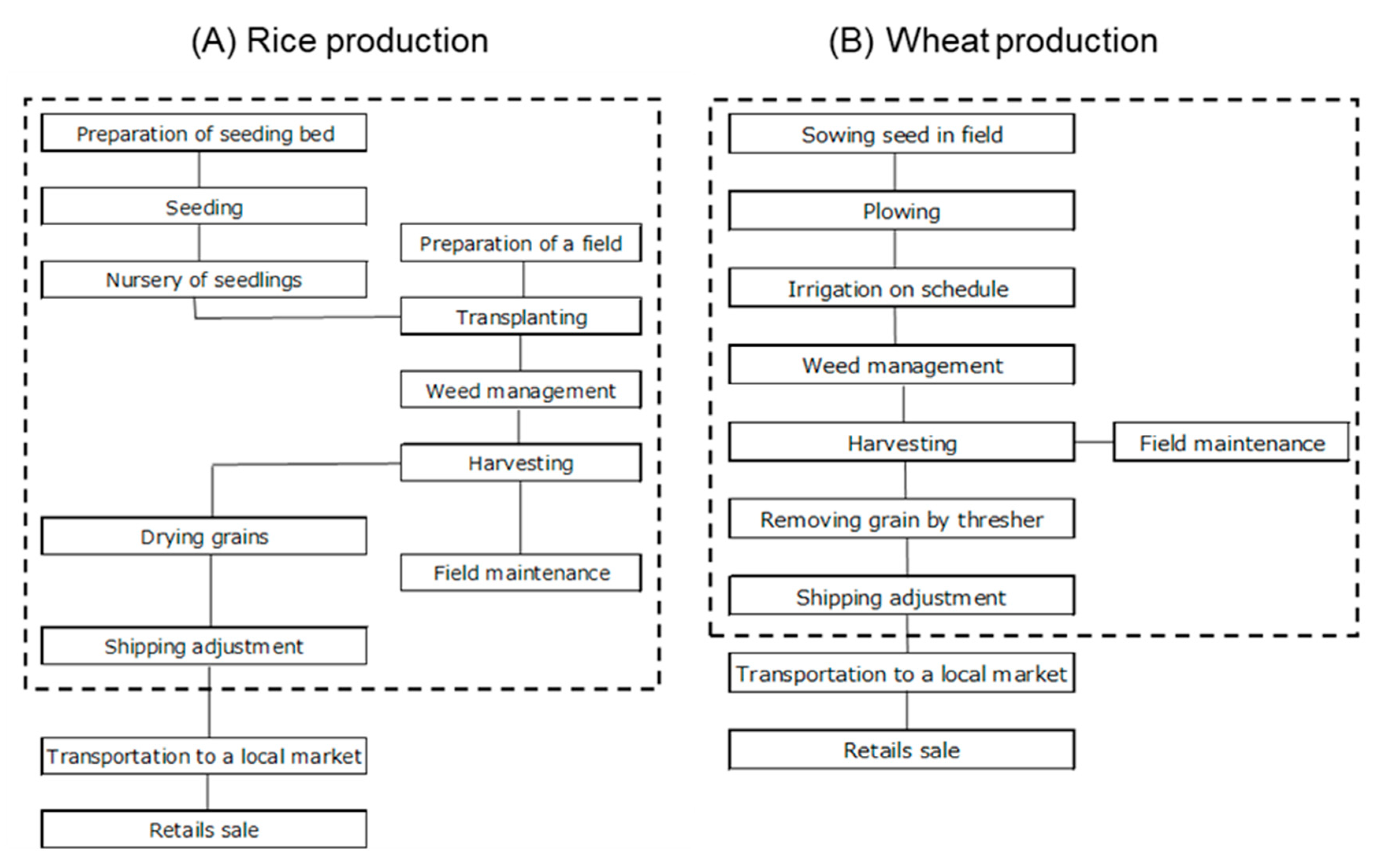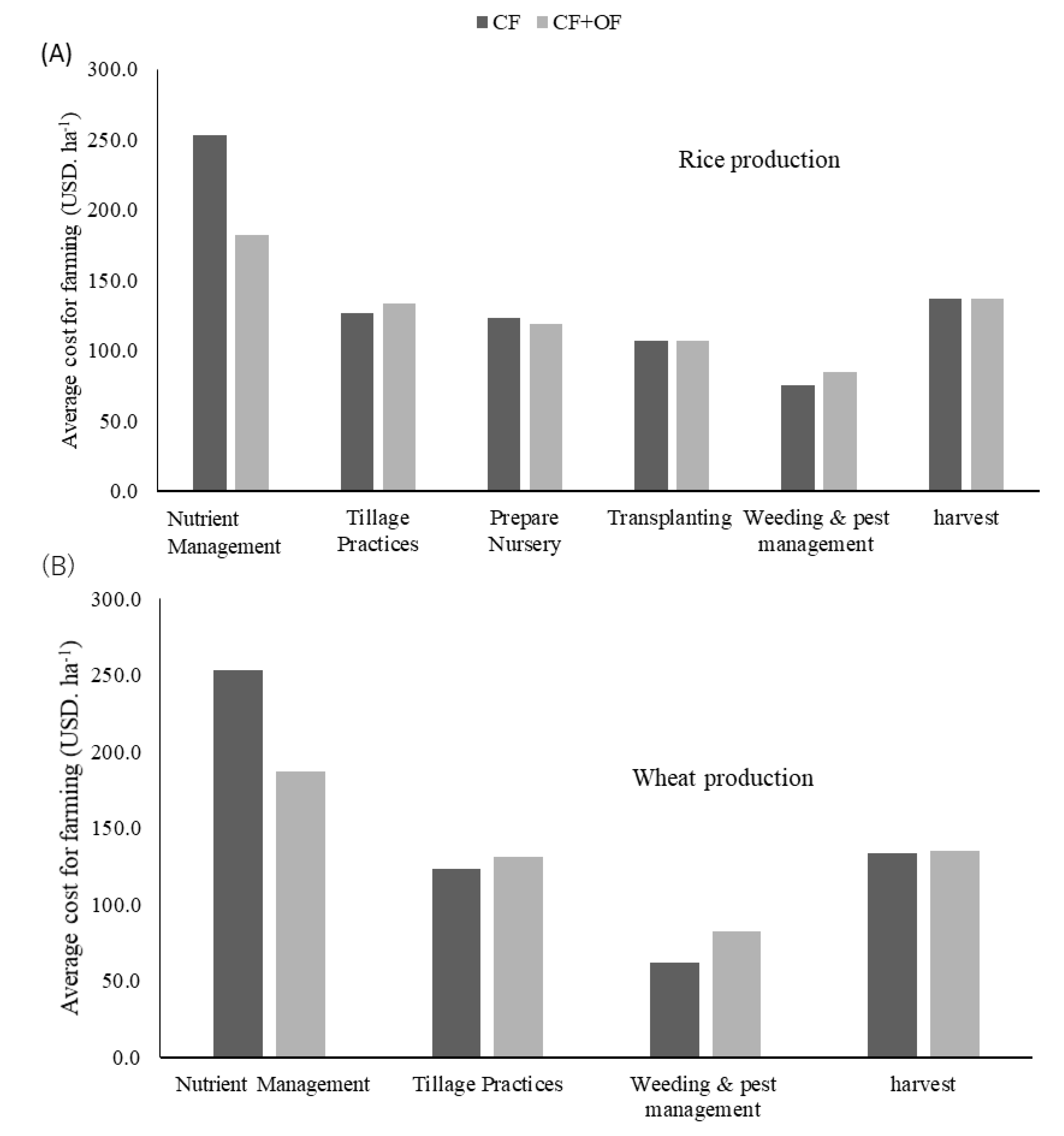Effects of Cultivating Rice and Wheat with and without Organic Fertilizer Application on Greenhouse Gas Emissions and Soil Quality in Khost, Afghanistan
Abstract
:1. Introduction
2. Materials and Methods
2.1. Description of the Rice–Wheat Double Cropping System Analyzed in This Study
2.2. Data Collection and Farming Practices
2.3. Life Cycle Assessment of the Double Cropping Systems
2.3.1. Goal and Scope Definition
2.3.2. Inventory Analysis
2.4. Soil Sampling and Its Analyses
2.4.1. Soil Sampling
2.4.2. Statistical Analysis
2.5. Economic Analysis
3. Results
3.1. Life Cycle Impact Analysis
3.2. Total Carbon, Active Carbon, and Total Nitrogen
3.3. Soil Chemical Properties
3.4. Wheat and Rice Yield and Economic Analysis
4. Discussion
4.1. Interpretation of LCA
4.2. Changes in Soil Properties by Organic Fertilizer Application
4.3. Challenges to Overcome Low Crop Productivity
4.4. Economic Advantages of Organic Fertilizer Application
5. Conclusions
Supplementary Materials
Author Contributions
Funding
Acknowledgments
Conflicts of Interest
References
- Cemtrala Intellligence Agency. The World Fact Book 2012. Available online: https://www.cia.gov/library/publications/the-world-factbook/geos/af.html (accessed on 26 March 2020).
- Kelly, A.T. Rebuilding Afghanistan’s Agriculture Sector; Asian Development Bank: Mandaluyong, Philippines, 2003; Volume 5, p. 14. [Google Scholar]
- Abdiani, S. Effects of war on biodiversity and sustainable agricultural development in Afghanistan. J. Dev. Sustain. Agric. 2012, 7, 9–13. [Google Scholar]
- Favre, R.; Kamal, G.M. Watershed Atlas of Afghanistan; Government of Afghanistan, Ministry of Irrigation: Kabul, Afghanistan, 2004; pp. 137–144. [Google Scholar]
- Ayubi, A.G. Principle of Irrigation and Drainage; Aazem Publication: Kabul, Afghanistan, 2016; Volume 31, p. 174. [Google Scholar]
- Sameen, A.Q.; Zaghard, M.A. Soil Chemistry and Plant Nutrients; World Bank: Kabul, Afghanistan, 2008; pp. 58–295. [Google Scholar]
- Heeb, A.; Lundegardh, B.; Savage, G.P.; Ericsson, T. Impact of organic and inorganic fertilizers on yield, taste, and nutritional quality of tomatoes. J. Plant Nutr. Soil Sci. 2006, 169, 535–541. [Google Scholar] [CrossRef]
- Oyewole, C.I.; Opaluwa, H.; Omale, R. Response of Tomato (Lycopersicon esculentum): Growth and yield, to rates of mineral and poultry manure application in the guinea savanna agro- ecological zone in Nigeria. J. Biol. Agric. Healthc. 2012, 2, 44–56. [Google Scholar]
- Milbrandt, A.; Overend, R. Agricultural resources. In Assessment of Biomass Resources in Afghanistan; NREL: Golden, CO, USA, 2011; pp. 6–7. [Google Scholar]
- Tadesse, T.; Dechassa, N.; Bayu, W.; Gebeyehu, S. Effects of farmyard manure and inorganic fertilizer application on soil physico-chemical properties and nutrient balance in rain-fed lowland rice ecosystem. Am. J. Plant Sci. 2013, 4, 309–316. [Google Scholar] [CrossRef] [Green Version]
- Akinrinde, E.A. Soils: Nature, Fertility Conservation and Management; AMS Publishing: Providence, RI, USA, 2004; Volume 78. [Google Scholar]
- Yagioka, A.; Komatsuzaki, M.; Kaneko, N. The effect of minimum tillage with weed cover mulching on organic daikon (Raphanus sativus var. longipinnatus cv. Taibyousoufutori) yield and quality and on soil carbon and nitrogen dynamics. Biol. Agric. Hortic. 2014, 30, 228–242. [Google Scholar] [CrossRef]
- Arai, M.; Minamiya, Y.; Tsuzura, H.; Watanabe, Y.; Yagioka, A.; Kaneko, N. Changes in water stable aggregate and soil carbon accumulation in a no-tillage with weed mulch management site after conversion from conventional management practices. Geoderma 2014, 221, 50–60. [Google Scholar] [CrossRef] [Green Version]
- Hashimi, R.; Afghani, A.K.; Borhan, I.; Moqbal, M.I.; Hashimi, M.H. Effect of land-use change on water-stable aggregates and soil chemical properties within of two cultivated fields in khost province, Afghanistan. Int. J. Dev. Res. 2019, 9, 30187–30192. [Google Scholar]
- Lal, R. Soil carbon sequestration and aggregation by cover cropping. J. Soil Water Conserv. 2015, 70, 329–339. [Google Scholar] [CrossRef]
- Mustafa, A.; Minggang, X.; Shah, S.A.A.; Abrar, M.M.; Nan, S.; Baoren, W.; Núñez-Delgado, A. Soil aggregation and soil aggregate stability regulate organic carbon and nitrogen storage in a red soil of southern China. J. Environ. Manag. 2002, 270, 110894. [Google Scholar] [CrossRef] [PubMed]
- Galati, A.; Gristina, L.; Crescimanno, M.; Barone, E.; Novara, A. Towards more efficient incentives for agri-environment measures in degraded and eroded vineyards. Land Degrad. Dev. 2015, 26, 557–564. [Google Scholar] [CrossRef]
- Lal, R. Soil degradation and environment quality in south Asia. Int. J. Ecol. Environ. Sci. 2007, 33, 91–103. [Google Scholar]
- Batabyal, K. Nutrient Management for Improving Crop, Soil, and Environmental Quality. In Essential Plant Nutrients; Springer: Cham, Switzerland, 2017; pp. 445–464. [Google Scholar]
- Choudhury, A.T.M.A.; Kennedy, I.R. Nitrogen fertilizer losses from rice soils and control of environmental pollution problems. Commun. Soil Sci. Plan Anal. 2005, 36, 1625–1639. [Google Scholar] [CrossRef]
- Dutreuil, M.; Wattiaux, M.; Hardie, C.A.; Cabrera, V.E. Feeding strategies and manure management for cost-effective mitigation of greenhouse gas emissions from dairy farms in Wisconsin. J. Dairy Sci. 2014, 97, 5904–5917. [Google Scholar] [CrossRef] [PubMed]
- Weil, R.R.; Brady, N.C. The Nature and Properties of Soils, 15th ed.; Pearson Education Limited: London, UK, 2017; pp. 615–616. [Google Scholar]
- Oertel, C.; Matschullat, J.; Zurba, K.; Zimmermann, F.; Erasmi, S. Greenhouse gas emissions from soils—A review. Geochemistry 2016, 76, 327–352. [Google Scholar] [CrossRef] [Green Version]
- Lal, R.; Delgado, J.A.; Groffman, P.M.; Millar, N.; Dell, C.; Rotz, A. Management to mitigate and adapt to climate change. J. Soil Water Conserv. 2011, 66, 276–285. [Google Scholar] [CrossRef] [Green Version]
- Ross, S.M. Organic matter in tropical soils: Current conditions, concerns and prospects for conservation. Prog. Phys. Geogr. 1993, 17, 265–305. [Google Scholar] [CrossRef]
- Malhi, S.S.; Lemke, R.; Wang, Z.H.; Chhabra, B.S. Tillage, nitrogen and crop residue effects on crop yield, nutrient uptake, soil quality, and greenhouse gas emissions. Soil Till. Res. 2006, 90, 171–183. [Google Scholar] [CrossRef]
- Galati, A.; Oguntoyinbo, F.A.; Moschetti, G.; Crescimanno, M.; Settanni, L. The cereal market and the role of fermentation in cereal-based food production in Africa. Food Rev. Int. 2014, 30, 317–337. [Google Scholar] [CrossRef]
- Kakar, K.; Xuan, T.D.; Haqani, M.I.; Rayee, R.; Wafa, I.K.; Abdiani, S.; Tran, H.D. Current situation and sustainable development of rice cultivation and production in Afghanistan. Agriculture 2019, 9, 49. [Google Scholar] [CrossRef] [Green Version]
- Ahmadzai, M.K.; Eliw, M.; Zhou, D. Descriptive and Econometric Analysis of Wheat Production in Afghanistan (A Case Study in Paktia Province). South Asian J. Soc. Stud. Econ. 2019, 5, 1–10. [Google Scholar] [CrossRef]
- Jalal, A.; Jeff, A. Grain and Feed in Afghanistan; Global Agricultural Information Network: Kabul, Afghanistan, 2013; pp. 1–8. [Google Scholar]
- World Weather Online. Statistics of Rainfall and Temperature of Khost Province. Available online: https://www.worldweatheronline.com/khost-weather-averages/khowst/af.aspx (accessed on 18 April 2020).
- Hashimi, R.; Komatsuzaki, M.; Mineta, T.; Kaneda, S.; Kaneko, N. Potential for no-tillage and clipped-weed mulching to improve soil quality and yield in organic eggplant production. Biol. Agric. Hortic. 2019, 35, 158–171. [Google Scholar] [CrossRef]
- Wali, E.; Datta, A.; Shrestha, R.P.; Shrestha, S. Development of a land suitability model for saffron (Crocus sativus L.) cultivation in Khost Province of Afghanistan using GIS and AHP techniques. Arch. Agron. Soil Sci. 2016, 62, 921–934. [Google Scholar] [CrossRef]
- International Organization for Standardization 14040. Methodological Framework. Available online: https://web.stanford.edu/class/cee214/Readings/ISOLCA.pdf (accessed on 25 June 2020).
- National Institute for Agro-Environmental Sciences. Data collection. In Manual for Life Cycle Assessment of Agricultural Practices in Japan; National Institute for Agro-Environmental Sciences: Tsukuba, Japan, 2003; pp. 8–23. [Google Scholar]
- Guideline for Prediction Procedure of Greenhouse Gas Emissions. Available online: https://www.env.go.jp/policy/local_keikaku/data/guideline.pdf (accessed on 2 May 2020).
- Life Cycle Assesssment. In Proceedings of the Council of LCA Promotion, Tokyo, Japan, 5 February 1998.
- Weil, R.R.; Islam, K.R.; Stine, M.A.; Gruver, J.B.; Samson-Liebig, S.E. Estimating active carbon for soil quality assessment: A simplified method for laboratory and field use. Am. J. Altern. Agric. 2003, 18, 3–17. [Google Scholar]
- Yamaki, A. A rapid UV absorption method for determination of nitrate in soil extracts. Jpn. J. Soil. Sci. Plant. Nutr. 2003, 74, 195–197. [Google Scholar]
- Editorial Committee of Soil Environmental Analysis. Soil Environmental Analysis, 4th ed.; Hakuyu Press: Tokyo, Japan, 2008. [Google Scholar]
- Gee, G.W.; Bauder, J.W. Particle-size Analysis. In Methods of Soil Analysis, Part 1. Physical and Mineralogical Methods; Klute, A., Ed.; ASA: Madison, WI, USA, 1986; pp. 399–404. [Google Scholar]
- StatView for Windows; v. 5.0.1; SAS Institute, Inc.: Cary, NC, USA, 1998.
- Huan-Ping, H.; Shi-Ming, M.; Er-Da, L.; Ying-Chun, L.; Heng-Yang, Z. Benefits comparison analysis of different rice and wheat cropping patterns to adapt to climate change. Adv. Clim. Chang. Res. 2013, 4, 182–189. [Google Scholar] [CrossRef]
- The World Bank. Fertilizer Consumption. Available online: https://data.worldbank:indicator/AG.CON.FERT.ZS (accessed on 15 June 2020).
- Antonious, G.F. Biochar and animal manure impact on soil, crop yield and quality. Agric. Waste Residues Intech Open 2018, 29, 45–67. [Google Scholar]
- Shahzad, K.; Khan, A.; Richards, M.; Smith, J.U. The impact of treatment of organic manures on future soil carbon sequestration under different tillage systems in Pakstan. Pak. J. Agric. Sci. 2017, 54, 277–286. [Google Scholar] [CrossRef] [Green Version]
- Aguirre-Villegas, H.A.; Larson, R.A. Evaluating greenhouse gas emissions from dairy manure management practices using survey data and lifecycle tools. J. Clean. Prod. 2017, 143, 169–179. [Google Scholar] [CrossRef]
- Galloway, J.N.; Townsend, A.R.; Erisman, J.W.; Bekunda, M.; Cai, Z.; Freney, J.R.; Martinelli, L.A.; Seitzinger, S.P.; Sutton, M.A. Transformation of the nitrogen cycle: Recent trends, questions, and potential solutions. Science 2008, 320, 889–892. [Google Scholar] [CrossRef] [Green Version]
- Cai, Z.; Yan, X.; Yan, G.; Xu, H.; Tsuruta, H.; Yagi, K.; Minami, K. Methane and nitrous oxide emissions from rice paddy fields as affected by nitrogen fertilizers and water management. Plant Soil 1997, 196, 7–14. [Google Scholar] [CrossRef]
- Wassmann, R.; Neue, H.U.; Lantin, R.S.; Makarim, K.; Chareonsilp, N.; Buendia, L.V.; Rennenberg, H. Characterization of methane emissions from rice fields in Asia: II. Differences among irrigation, rainfed, and deepwater rice. Nutr. Cycl. Agroecosyst. 2000, 58, 13–22. [Google Scholar] [CrossRef]
- Yan, X.; Ohara, T.; Akimoto, H. Development of region-specific emission factors and estimation of methane emission from rice fields in the East, Southeast and South Asian countries. Glob. Chang. Biol. 2003, 9, 237–254. [Google Scholar] [CrossRef]
- Zibilske, L.M.; Bradford, J.M.; Smart, J.R. Conservation tillage induced changes in organic carbon, total nitrogen and available phosphorus in a semi-arid alkaline subtropical soil. Soil Till. Res. 2002, 66, 153–163. [Google Scholar] [CrossRef]
- Matsuura, E.; Komatsuzaki, M.; Hashimi, R. Assessment of soil organic carbon storage in vegetable farms using different farming practices in the Kanto Region of Japan. Sustainability 2018, 10, 152. [Google Scholar] [CrossRef] [Green Version]
- Masunaga, T.; Kamidohzono, A.; Nezam, A.W.; Sadat, S.A. Paddy Soil Properties in Nangarhar Province, East Afghanistan. Jpn. Agric. Res. Q. 2014, 48, 299–306. [Google Scholar] [CrossRef]
- Komatsuzaki, M.; Syuaib, M.F. Comparison of the farming system and carbon sequestration between conventional and organic rice production in West Java, Indonesia. Sustainability 2010, 2, 833–843. [Google Scholar] [CrossRef] [Green Version]
- Hutchinson, J.J.; Campbell, C.A.; Desjardins, R.L. Some perspectives on carbon sequestration in agriculture. Agric. For. Meteorol. 2007, 142, 288–302. [Google Scholar] [CrossRef]
- Hui, L.I.; Feng, W.T.; He, X.H.; Ping, Z.H.U.; Gao, H.J.; Nan, S.U.N.; Xu, M.G. Chemical fertilizers could be completely replaced by manure to maintain high maize yield and soil organic carbon (SOC) when SOC reaches a threshold in the Northeast China Plain. J. Integr. Agric. 2017, 16, 937–946. [Google Scholar] [CrossRef]
- Mooshammer, M.; Hofhansl, F.; Frank, A.H.; Wanek, W.; Hämmerle, I.; Leitner, S.; Schnecker, J.; Wild, B.; Watzka, M.; Keiblinger, K.M.; et al. Decoupling of microbial carbon, nitrogen, and phosphorus cycling in response to extreme temperature events. Sci. Adv. 2017, 3, e1602781. [Google Scholar] [CrossRef] [Green Version]
- Jacques Agra Bezerra da Silva, Y.; Williams Araújo do Nascimento, C.; Jacques Agra Bezerra da Silva, Y.; Miranda Biondi, C.; Cordeiro Atanázio Cruz Silva, C.M. Rare Earth Element Concentrations in Brazilian Benchmark Soils. Rev. Bras. Ciênc. Solo 2016, 40, 1–13. [Google Scholar]
- Wang, S.Q.; Yu, G.R. Ecological stoichiometry characteristics of ecosystem carbon, nitrogen and phosphorus elements. Acta Ecol. Sin. 2008, 28, 3937–3947. [Google Scholar]
- Brady, N.C.; Weil, R.R. The Nature and Properties of Soils; Pearson Prentice Hall: Upper Saddle River, NJ, USA, 2002; pp. 413–436. [Google Scholar]
- Landon, J.R. (Ed.) Booker Tropical Soil Manual: A Handbook for Soil Survey and Agricultural Land Evaluation in the Tropics and Subtropics; Longman Scientific and Technical: New York, NY, USA, 1991; pp. 106–156. [Google Scholar]
- Chesworth, W. Encyclopedia of Soil Science; Springer: Dordrecht, The Netherlands, 2008. [Google Scholar]
- Johnson, A.H.; Andersen, S.B.; Siccama, T.G. Acid rain and soils of the Adirondacks. I. Changes in pH and available calcium. Can. J. For. Res. 1994, 24, 39–45. [Google Scholar] [CrossRef]
- David, J.M. Biochar and compost increase crop yields but the effect is short term on sandplain soils of Western Australia. Pedosphere 2015, 25, 720–728. [Google Scholar] [CrossRef] [Green Version]
- Manzoor, Z.; Awan, T.H.; Zahid, M.A.; Faiz, F.A. Response of rice crop (super basmati) to different nitrogen levels. J. Anim. Plant Sci. 2006, 16, 52–55. [Google Scholar]
- Tahir, M.; Tanveer, A.; Shah, T.H.; Fiaz, N.; Wasaya, A. Yield response of wheat (Triticum aestivum L.) to boron application at different growth stages. Pak. J. Life Soc. Sci. 2009, 7, 39–42. [Google Scholar]
- The Jakalta Post Economic Crisis Helps Boost Growth in Indonesia’s Organic Fertilizer Sector. 2009. Available online: http://www.thejakartapost.com/news/2009/03/02/economic-crisis-helps-boost-growth-indonesia039s-organic-fertilizer-sector.html (accessed on 26 March 2020).






| Conventional Farming with Organic Fertilizer CF+OF | Conventional Farming CF | Month | Machinery Used for Cultivation | Type of Fuel | |
|---|---|---|---|---|---|
| Nursery | Plow machine for nursery in field for seedling | Plow machine for nursery in field for seedling | Mid-May | ||
| Land preparation | Application of cattle manure | Early-June | Massey-Ferguson 241 Tractor | Diesel | |
| Plowing field | Plowing field | Early-June | rotary tiller | Diesel | |
| Transplanting | Paddy field leveling and preparation | Paddy field leveling and preparation | Mid June | Massey-Ferguson 241 Tractor | Diesel |
| Rice transplanting by hand | Rice transplanting by hand | Mid-June | |||
| Pest control | Weeding by hand and herbicide | Weeding by hand and herbicide | July | ||
| Harvesting | Rice harvesting by hand | Rice harvesting by hand | Mid-Sep | ||
| Drying and cleaning | Rice grain straw transfer to special place | Rice grain straw transfer to special place | Oct | Massey-Ferguson 241 Tractor + trailer | Diesel |
| Rice grain threshing from straw | Rice grain threshing from straw | Mid-Oct | Using Massey-Ferguson 241 Tractor | Diesel | |
| Making bundle from rice straw (Manually) | Making bundle from rice straw (Manually) | Mid-Oct | |||
| Husk removing from grain | Husk removing from grain | End of Oct | Huller | Diesel | |
| Cleaning rice grain by natural air (Manually) | Cleaning rice grain by natural air (Manually) | End of Oct | |||
| Land preparation | Application of cattle manure | End of Oct | Massey-Ferguson 241 Tractor + trailer | Diesel | |
| Nursery | Seeding and plowing field | Seeding and plowing field | Nov | rotary tiller | Diesel |
| Pest control | Weeding by hand and using herbicide | Weeding by hand and herbicide | Apr | ||
| Water management | Irrigation by schedule | Irrigation by schedule | Nov–May | ||
| Harvesting | Wheat harvesting using sickle by hand | Wheat harvesting using sickle by hand | End of May | ||
| Drying and cleaning | Wheat straw transfer to special place (Darmand) | Wheat straw transfer to special place (Darmand) | End of May | Massey-Ferguson 241 Tractor +trailer | Diesel |
| Using thresher for wheat grain | Using thresher for wheat grain | Early-June | Massey-Ferguson 241 Tractor attached wheat Thresher | Diesel |
| Process | Subsystem | Sources of Data |
|---|---|---|
| 1. Rice cultivation | Fertilizer | Measure data from farmer interview, |
| NIAES [35], MOE [36] | ||
| Pesticides | Data from questionnaire, JLCA [37] | |
| Mechanical field operations | Measure data from farmer interview, MOE [36] | |
| Plastic waste disposal | Data from questionnaire | |
| Transportation | Data from questionnaire, MOE [36] | |
| 2. Wheat cultivation | Fertilizer | Measure data from farmer interview, |
| NIAES [35], MOE [36] | ||
| Pesticides | Data from questionnaire, JLCA [37] | |
| Mechanical field operations | Measure data from interview session MOE [36] | |
| Plastic waste disposal | Data from questionnaire | |
| Transportation | Data from questionnaire, MOE [36] |
| Input | Output | ||||
|---|---|---|---|---|---|
| Unit | Conventional Farming | Conventional with Organic Fertilizer | Conventional Farming | Conventional with Organic Fertilizer | |
| Energy consumption | |||||
| Diesel | MJ ha−1 | 7988.4 | 7512.9 | ||
| Electricity | kWh | 0 | 0 | ||
| Production cost | |||||
| Chemical fertilizers | USD * | 507 | 380.4 | ||
| Organic fertilizers | USD | 0 | 51.9 | ||
| Agrochemicals | USD | 136.5 | 167.1 | ||
| Fuels | USD | 115.8 | 122.9 | ||
| Nitrogen inputs | |||||
| Chemical fertilizers | kg ha−1 | 238 | 178.5 | ||
| Organic fertilizers | kg ha−1 | 0 | 180 | ||
| Straw residues | kg ha−1 | 0 | 0 | ||
| Yields | |||||
| Rice | Mg ha−1 | 3.75 | 3.4 | ||
| Wheat | Mg ha−1 | 3.85 | 3.75 | ||
| Unit | Wheat | Rice | Total | Wheat | Rice | Total | |
|---|---|---|---|---|---|---|---|
| GHG emission from | |||||||
| Fuel | kg CO2 | 243 | 382 | 153 | 485 | ||
| Plastic wastes | kg CO2 | 186 | 193 | 186 | 93 | ||
| Fertilizers + agrochemicals | kg CO2 | 248 | 148 | 225 | 231 | ||
| Total GHG emissions | kg CO2 | 677 | 723 | 1400 | 564 | 809 | 1373 |
| CO2 absorption by crop | kg ha−1 | −4987 | −5500 | −10,487 | −5500 | −5647 | −11,147 |
| GHG balance | −4310 | −4777 | −9087 | −4936 | −4838 | −9774 |
| Soil Depth (cm) | Farming System | pH | TC (%) | AC (mg kg−1) | TN (g kg−1) | C/N | Inorganic N (mg kg−1) | P (mg kg−1) | K+ (mg kg−1) | Ca2+ (mg kg−1) | Mg2+ (mg kg−1) |
|---|---|---|---|---|---|---|---|---|---|---|---|
| 0–15 | CF+OF | 8.4 | 1.7 a | 1098.1 a | 1.6 a | 10.2 | 51.3 ab | 84.85 b | 122.1 | 4740.6 a | 433.8 a |
| CF | 8.3 | 1.3 c | 930.6 b | 1.1 c | 12.4 | 55.0 a | 47.7 c | 123.4 | 4457.1 b | 416.3 b | |
| 15–30 | CF+OF | 8.0 | 1.4 b | 990.1 ab | 1.3 b | 11.7 | 47.3 b | 94.9 a | 96.8 | 4690.1 a | 435.0 a |
| CF | 8.0 | 1.1 d | 932.4 b | 0.9 d | 11.4 | 63.0 a | 45.2 c | 93.8 | 4381.3 b | 422.5 b | |
| ANOVA Significance | |||||||||||
| Farming system (FS) | NS | *** | ** | *** | NS | ** | *** | NS | * | ** | |
| Depth (D) | NS | ** | NS | ** | NS | NS | * | NS | NS | NS | |
| FS × D | NS | NS | NS | NS | * | * | ** | NS | NS | NS | |
| Farming system | Sand | Silt | Clay | Bulk Density (Mg m–3) | SOC (%) | SCS Mg ha−1 |
|---|---|---|---|---|---|---|
| (%) | ||||||
| CF+OF | 46.4 | 40.6 | 13.1 | 0.74 | 1.7 | 18.5 |
| CF | 48.0 | 36.7 | 15.4 | 0.75 | 1.3 | 14.5 |
| ANOVA Significance | ||||||
| Farming system | NS | NS | NS | NS | *** | *** |
| TC | AC | TN | C/N | Inorganic N | P | K+ | Ca2+ | |
|---|---|---|---|---|---|---|---|---|
| AC | 0.519 *** | |||||||
| TN | 0.859 *** | 0.457 *** | ||||||
| C/N | −0.048 | −0.021 | −0.094 | |||||
| Inorganic N | −0.109 | −0.125 * | −0.093 | −0.071 | ||||
| P | 0.263 * | 0.169 * | 0.401 ** | −0.061 | −0.273 * | |||
| K+ | 0.402 *** | 0.032 | 0.337 ** | −0.263 ** | 0.011 | 0.002 | ||
| Ca2+ | 0.014 | −0.017 | 0.011 | −0.205 * | 0.002 | 0.098 | 0.058 | |
| Mg2+ | −0.007 | 0.024 | −0.018 | 0.077 | −0.159 * | 0.205 * | −0.487 ** | 0.02 |
| Crop | Farming System | Yield (ha−1) | Price (USD kg−1) | Gross Income (USD ha−1) | Total Expenditure (USD ha−1) | Net Income (USD ha−1) | Benefit Cost Ratio |
|---|---|---|---|---|---|---|---|
| Wheat | CF+OF | 3.7 | 0.3 | 962.0 | 536.6 | 425.4 | 1.8 |
| CF | 3.8 | 0.3 | 988.0 | 572.7 | 415.4 | 1.7 | |
| Rice | CF+OF | 3.4 | 0.6 | 1878.5 | 762.6 | 1115.9 | 2.5 |
| CF | 3.7 | 0.6 | 2044.3 | 822.3 | 1222.0 | 2.5 |
© 2020 by the authors. Licensee MDPI, Basel, Switzerland. This article is an open access article distributed under the terms and conditions of the Creative Commons Attribution (CC BY) license (http://creativecommons.org/licenses/by/4.0/).
Share and Cite
Hashimi, R.; Matsuura, E.; Komatsuzaki, M. Effects of Cultivating Rice and Wheat with and without Organic Fertilizer Application on Greenhouse Gas Emissions and Soil Quality in Khost, Afghanistan. Sustainability 2020, 12, 6508. https://doi.org/10.3390/su12166508
Hashimi R, Matsuura E, Komatsuzaki M. Effects of Cultivating Rice and Wheat with and without Organic Fertilizer Application on Greenhouse Gas Emissions and Soil Quality in Khost, Afghanistan. Sustainability. 2020; 12(16):6508. https://doi.org/10.3390/su12166508
Chicago/Turabian StyleHashimi, Rahmatullah, Eri Matsuura, and Masakazu Komatsuzaki. 2020. "Effects of Cultivating Rice and Wheat with and without Organic Fertilizer Application on Greenhouse Gas Emissions and Soil Quality in Khost, Afghanistan" Sustainability 12, no. 16: 6508. https://doi.org/10.3390/su12166508
APA StyleHashimi, R., Matsuura, E., & Komatsuzaki, M. (2020). Effects of Cultivating Rice and Wheat with and without Organic Fertilizer Application on Greenhouse Gas Emissions and Soil Quality in Khost, Afghanistan. Sustainability, 12(16), 6508. https://doi.org/10.3390/su12166508






